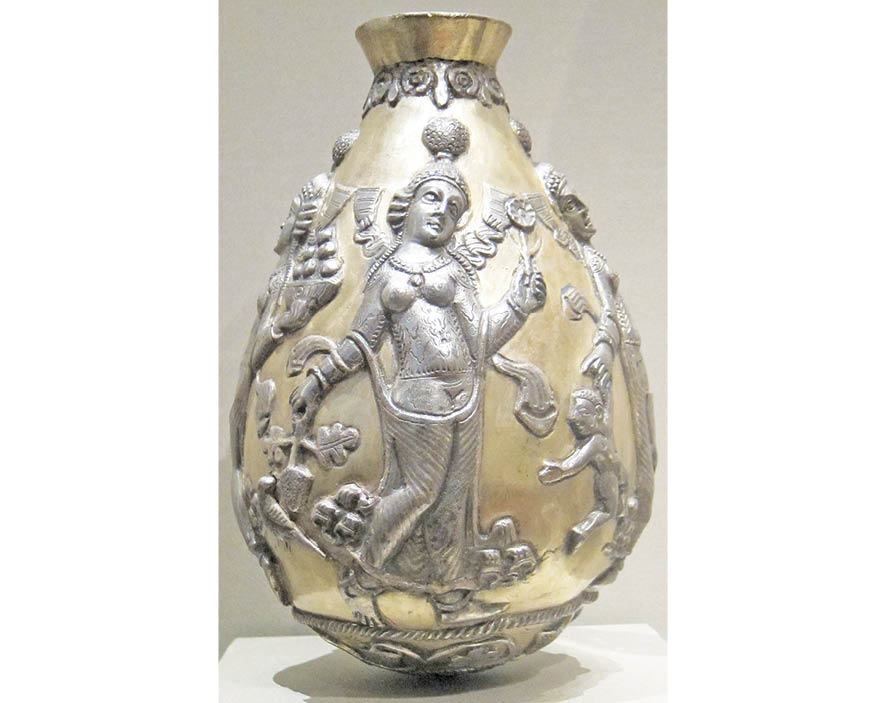The earliest form of life began in water because of the play of extreme hot and cold temperatures inside and outside the thermal-vents along the ocean beds which created life (science calls this molecular synthesis).This magical quality of water, which generates a rich biodiversity, right from the water-bacteria to a giant whale, is due to the feminine side of nature, which Hindus call ‘Prakriti’ and we call ‘Avan Arduisur Banu’. Why the feminine side of nature? Because it gives birth, nourishes and supports life. In the Vedas, rivers, seas, wells, oceans, lakes (any water-body) were given extraordinary power or Shakti.
For example, the river Saraswati, the most celebrated river in the Vedas, is personified as the Goddess of all forms of art, i.e. all forms of mental-creativity. The Rig Veda calls Saraswati the ‘Celestial cow’ that nourishes people with her milk because the cow denotes the feminine power that sustain life. Even the sacred element of Earth is alluded to the mystical, wish-fulfilling cow called ‘Kamadhenu’ and this combination of water and earth is life’s sustainer.
The belief that water is the origin of life was shared by most ancient civilizations, including the Egyptian, the Mesopotamian and the Vedic. Since all these civilizations flourished on the banks of rivers the Nile, the Euphrates and the Indus respectively their worship of water stemmed from the recognition of its significant role in human history. In each case, the river acted as a catalyst in the evolution of particular socio-economic and cultural patterns. The role of the river as the shaper of people’s lives as material sustainer and spiritual nourisher is celebrated in the myths that form the core of most ancient religious practices. Many modern day Hindu beliefs about rivers are inherited from the Indo-European or Aryan tribes, who are thought to have first settled beside the river Sindu. The beliefs, enshrined in the Vedic ‘samhitas’, are kept alive in the contemporary Hindu customs.
In most religions, there is a clear distinction between celestial waters that come from rain and rivers and the terrestrial waters of the oceans. Accordingly, it was the celestial waters which had the magical procreative of the good as against the destructive powers of evil that lie in the depths of the oceans. The elevated status of river waters is reiterated in the mythical accounts of superhuman endeavours employed to bring these waters down from the abode of the Gods to the earth. The popular myth of the Ganga being brought down to earth by King Bhagirath after a thousand years of penance is an instance.
Like the other sacred elements of nature, water is the divine witness to all human deeds and hence, most religious rites and rituals represent water in a pitcher. Water also represents intellect and knowledge and hence the river Saraswati represents ‘Gyaan’. All the Upanishads confirm that without Gyaan, especially ‘Atma-Gyaan’ (spiritual knowledge), it is impossible to reach God. Knowledge is more important than mere rituals and rites done by other people (intermediaries) on payment of money. Knowledge says the Bhagvad Gita helps even the most sinful person to change his life and cross the ocean (Bhav-Sagar) of existence (Samsara).
Since knowledge and action based on knowledge, can destroy the accumulated karma of one’s thoughtless actions, nothing is more pure than knowledge. And since the metaphors of revelation and passage, and the values of sustenance and mystery meet in the image of the river, Saraswati is therefore worshipped both as a bestower of knowledge and as a guide who leads the devotee to ‘moksha’.
Again, in all religions, it is our duty to keep the sacred element of water pure and not defile it in any way but with the passage of time, the traditional relevance is lost and man-made rituals make people believe that it is okay to dirty the water. Some say that the Ganga has been polluted beyond repair. From dead bodies to human waste to deadly factory chemicals all find their way to the Ganga. The government has drawn-up massive plans costing thousands of crores to clean-up the Ganga and some other rivers, but as far as we can see, it is fighting a losing battle.
Even an educated community like ours thinks it is alright to throw coconuts, flowers, rice and even Dar-ni-pori into the water and think they are doing something good. Also, while travelling to Udvada by train, some people throw coins into the river while passing the Vasai-Bridge… All this is neither religion nor spirituality since it only defiles the water. Rather, it’s a threat to our environment. If emissions due to misguided human activity continue to dirty our rivers, lakes and seas, it will completely damage our Earth’s eco-system causing disruptions in the food-chain, encouraging global-warming, upsetting the balance and reducing oxygen in the air.
As psychologist and visionary Carl Jung warned us, faith can easily degenerate into spiritual inertia and thoughtless compliance with dogma, and cultural stagnation. After all, the cultural consciousness must be characterised by the fluid energy of the river, not by the sluggishness of the swamp. Just imagine, in those days, Carl Jung was eco-conscious about keeping the sacred element of water clean and pure.
As I said in the beginning of this article, water gave us life- let’s be grateful for this and not make it impure due to misguided religious sentiments!
- The Real Beauty Secret - 13 April2024
- Frenymai And The Fake Godman – II - 30 March2024
- Meherbai’s Mandli Discusses Coomi Kaajwali’s Match-Making Secrets! - 16 March2024
